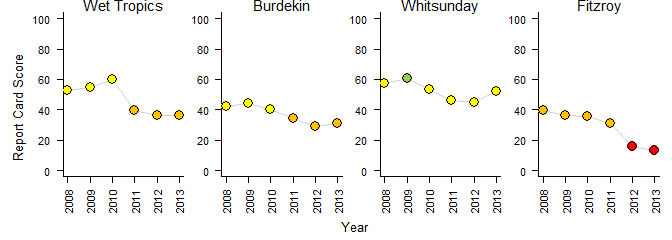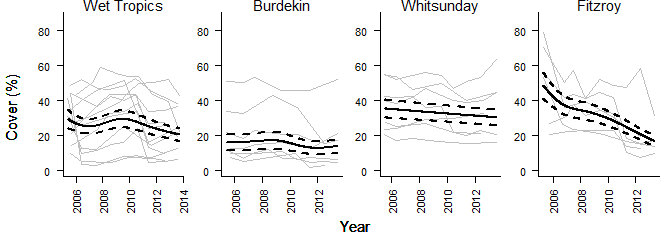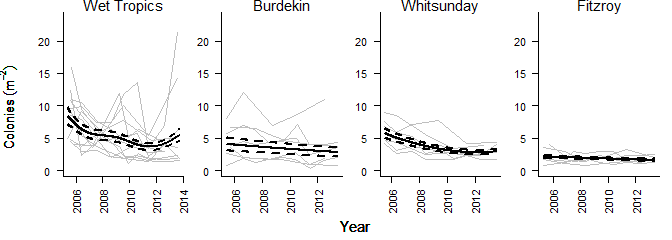Reef Plan Marine Monitoring Program - Project - Inshore coral reef monitoring (AIMS) OLD

Introduction
Coral reefs in the coastal and inshore zones of the Great Barrier Reef (GBR) are highly valued for recreation and local tourism, but their proximity to land exposes these reefs to land runoff carrying excess amounts of fine sediments and nutrients from developed catchments. The land management initiatives under the Australian and Queensland Government's Reef Water Quality Protection Plan 2013 (Reef Plan) are key tools to improve the water quality entering the GBR and will, in the long-term, improve the environmental conditions for inshore coral reefs. Long-term monitoring of 32 inshore reefs (Figure 1) is part of the Reef Plan and is fundamental to determine the condition of inshore coral reefs and long-term trends related to Reef Plan’s actions on the catchment.
The condition of coral communities on inshore reefs of the GBR has been in a state of decline in recent years. The ninth MMP inshore coral reef survey completed in 2013 demonstrated the halting and reversal of these declines in all regions with the exception of the Fitzroy Region (Figure 2). Observed declines in coral community composition can be attributed to exposure to extreme weather events, including tropical cyclones and flooding in combination with responses to chronic environmental stress. The return to more moderate levels of runoff in 2013 and a lack of cyclone damage has allowed coral communities to begin to recover. Severe flooding in the Fitzroy Region again in 2013 has ensured the continued very poor condition of corals in that region.
This assessment highlights areas of the GBR where certain aspects of coral communities appear to be under stress and identifies likely causal environmental factors. The variation of environmental conditions between years, particularly the volume of river discharges during the wet season, is sufficient to alter the dynamics of coral reef communities on inshore reefs for extended periods. In all regions, the incidence of coral disease increased with the transition from a period of relatively low rainfall years up to 2007 to a series of years typified by high river discharge of local rivers. Water turbidity and the proportion of fine-grained particles in the reef sediments have also increased with increasing river discharge, affecting coral growth and recruitment, most likely due to light limitation and smothering.
This page summarises the coral reef component of the Reef Plan Marine Monitoring Program (MMP). Information about the whole program and links to other components can be found here.
Methods
The MMP inshore coral reef monitoring was started in 2005 at 32 inshore coral reefs (Figure 1). The reefs are located in 4 Natural Resource Management (NRM) Regions (the Wet Tropics, Burdekin, Mackay Whitsunday and Fitzroy Regions). Of these reefs, 15 are surveyed annually, with an additional 17 reefs surveyed every second year. Monitored reefs lie along a gradient of exposure to runoff, largely determined as increasing northerly distance from regionally important rivers. Reefs are assessed for their cover of hard coral, soft coral and macroalgae, as well as taxonomic diversity, coral demographics (monitoring of juvenile coral colonies, their sizes and their diversity) and coral settlement. The composition of benthic foraminiferal assemblages, as a bioindicator for water quality, is also assessed at the 14 “core” sites.
Figure 1: Sampling sites of the Reef Rescue MMP inshore coral monitoring. Core reef sites (red symbols) have annual coral reef benthos surveys, and regular water quality monitoring. Non-core reef sites (yellow symbols) have benthos surveys every two years and no water quality monitoring.
The following map shows a summary of the inshore water quality monitoring and coral reef monitoring. This map is downloadable as a KMZ. This layer shows three main datasets:
- Water quality monitoring loggers showing annual time series graphs of turbidity and chlorophyll from 2007-2011.
- Coral cover (percent) showing annual time series of hard coral, soft coral and macro algae from 2005-2011.
- Nutrient data (particulate nitrogen, particulate phosphorus, suspended solids, secchi depth) gathered from bucket samples as an average of all data from 2005-2011.
Key results
The condition of reefs in the Wet Tropics Region stabilised in 2013 to again be assessed as ‘poor’ (Figure 2). The overall condition of reefs declined steeply between 2010 and 2011 as a result of the losses in coral cover attributed to high levels of coral disease in the northern parts of the region and the impacts of Cyclone Yasi that were most severe in the southern parts (Figure 3). The reason for a lack of improvement in coral community condition varies within the region. In all sub-regions there has been a general increase in the cover of macroalgae. In the Barron-Daintree and Johnstone Russell-Mulgrave regions high levels of coral disease in 2010 and 2011 resulted in slow rates of coral cover increase that, in combination with crown-of-thorns seastars outbreaks, have seen further reductions in coral cover. The density of juvenile corals has also declined to low levels in these sub-regions (Figure 4). In contrast, while coral cover is still very low in the Herbert Tully sub-region, increases in the density of juvenile corals indicates some level of recovery. Of most concern in this region remains the proposed links between crown-of-thorn seastar outbreaks and poor water quality resulting from major flood events. Certainly the present outbreaks of crown-of-thorns seastars on reefs in this region coincide with the onset of high flows to the GBR in general.
The condition of coral communities in the Burdekin Region increased slightly in 2013, though following several years of decline remains ‘poor’ (Figure 2). This assessment has been influenced by low coral cover as a result of disturbances, most recently Cyclone Yasi in 2011 (Figure 3). Regionally low coral cover will have contributed to low and declining settlement of larvae with flow on effects to low numbers of juvenile corals (Figure 4). Of concern are two indications that environmental conditions may be compounding the effects of disturbance and so further suppressing the recovery potential of coral communities. Firstly, relatively high levels of disease coincided with the transition from a period of below median discharges from the Burdekin River to a period of wetter years starting in 2007. The implication being that environmental conditions had changed sufficiently to cause mortality among sensitive species and result in a further reduction of coral cover. Secondly, the cover of macroalgae has been persistently high on four of the five reefs with the poorest water quality. Macroalgae can suppress the recovery of coral communities following disturbance and will have contributed to the observed low densities of juvenile corals and low rates of cover increase on those reefs
Coral reef communities in the Mackay / Whitsunday region maintained a ’moderate‘ condition assessment in 2013 (Figure 2). The positive indicators of condition of low cover of macroalgae and moderate to high cover of corals (Figure 3) were balanced against slow rates of increase in hard coral cover. The density of juvenile corals was also a positive indicator of coral community condition. However, as the density of juvenile corals is standardised for the proportion of the substrate available to settlement the high proportion of substrate covered by fine sediments, and so not considered suitable for coral settlement, leads to a conservative assessment for this indicator in this region. The number of juvenile corals has been low for several years (Figure 4). It appears that high turbidity in this region has selected for coral communities tolerant of such conditions. We have noted increased levels of disease that coincide with periods of increased river discharge implying that the selection for corals tolerant of the environmental conditions in the region is an ongoing process
Coral communities in the Fitzroy Region continue to be assessed as being in ‘very poor’ condition (Figure 2). Exposure to low salinity flood waters in 2011 caused a marked reduction in coral cover and juvenile densities down to at least 2m depth on reefs inshore of Great Keppel Is (Figure 4). Elsewhere recovery from coral bleaching in 2006 and periodic storms has been compromised by a persistent bloom of macroalgae, high levels of disease and low numbers of juvenile corals, all linked to the influence that repeated flooding over recent years has had on environmental conditions within Keppel Bay.
FORAM index-based assessments of the reef condition reinforce observations from previous years of a substantial shift in community composition from those observed in 2005-2007 (GBR - Indicators of marine water quality - Benthic foraminifera (AIMS)). In all regions, values of the FORAM index declined to a ‘very poor’ rating as the abundance of autotrophic species, which favour high light and low nutrient environments, declined relative to the abundance of heterotrophic species, which are typically associated with lower light conditions and fine sediments high in organic matter. The consistency of this decline strongly implies an increase in fine sediments and or nutrients in all regions over the period 2009- 2013. The concurrent change in foraminiferal community composition, declines in coral community condition and declines in water quality combine to demonstrate that ecosystem responses coinciding with elevated levels of runoff are consistent across a range of benthic organisms.
The monitoring data show increases in mean turbidity and concentrations of suspended solids, chlorophyll and nutrients, both dissolved and particulate, and declines in Secchi depth that correspond to increased river flow in all regions (link to eAtlas MMP WQ page). This is particularly pronounced at reef sites which are close to the coast and frequently exposed to riverine flood plumes. The increased turbidity and suspended solids concentrations during the high-flow years of ~2008-2012 led to an increased supply of fine sediment to the reef substratum. There was a general increase in the proportions of fine-grained particles, nutrients and organic carbon in reefal sediments, however at individual reefs, the hydrodynamic setting determines whether particles accumulate over longer time frames.
The steady decline of the FORAM index on most reefs is a strong indication that the observed changes in water and sediment quality represent a shift in environmental conditions that were sufficient to alter the composition of benthic communities (GBR - Indicators of marine water quality - Benthic foraminifera (AIMS)). The general responses of coral reef communities to water quality are relatively well understood and contribute to differences in the composition of key organisms along environmental gradients in the inshore GBR. However, the processes shaping biological communities are complex due to interactions between environmental variables, other organisms and the effects of past disturbances events. In contrast to the relatively short life span of foraminifera, corals are long lived and their community composition reflects the cumulative result of selective pressures over longer time frames. Because of this, responses of corals are expected to be site-specific and exposure-dependent. In addition, corals are subject to acute disturbance events such as cyclones, crown-of-thorns seastar (COTS) outbreaks or thermal bleaching events. The potential role of poor water quality in suppressing the resistance to, or recovery from, these disturbances is critical for the resilience of coral communities on inshore reefs. We interpret the recent declines in our assessments of coral community health to reflect a combination of acute disturbances and environmental limitations to coral community resilience. It is of concern that the monitored resilience indicators (cover of macroalgae, juvenile density, rate of coral cover increase) along with the number of coral larvae settling to tiles have remained at low levels or declined over recent years. The effects were common in all regions, across environmental gradients and affecting a diversity of taxonomic groups, which makes the identification of individual areas most at risk to the effects of runoff a challenging task.
In addition to reducing the ability to recover from disturbance, degraded water quality potentially increases the susceptibility of corals to disturbance. The frequency and severity of disturbance events are projected to increase as a result of climate change. Any increase in susceptibility to these disturbances as a result of local stressors may be catastrophic for GBR inshore communities. Recent research into the interactions between water quality and climate change suggests that the tolerance to heat stress and ocean acidification of corals and foraminifera is reduced by exposure to contaminants including nutrients, herbicides and suspended particulate matter. Evidence is also accumulating that COTS outbreaks are initiated as a result of increased nutrient loads delivered to the GBR lagoon during major flood events. The resilience of inshore reefs will be severely compromised if declining water quality influences the severity (bleaching) and/or frequency (COTS) of disturbance events as well as reducing the recovery from such events. At present, there is a limited understanding of the cumulative impacts of these multiple pressures. The evidence summarised in the recent Reef Plan Scientific Consensus Statement “indicates that a reduction in catchment pollutant loads is essential to halt and reverse further decline in the GBR ecosystem condition at a time of rapidly warming climate and ocean acidification” (https://www.reefplan.qld.gov.au/about/scientific-consensus-statement.aspx). The continued monitoring of the coastal and inshore GBR lagoon is fundamental to determine the status of marine water quality and ecosystem health and long-term trends related to Reef Plan activities.
The detailed annual monitoring reports of this program are here.
Project meta-data
The full meta-data for this project can be found in the following record: Reef Plan Monitoring of Inshore Coral Reef Monitoring, Great Barrier Reef







